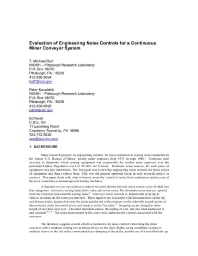Mining Publication: Evaluation of Engineering Noise Controls for a Continuous Miner Conveyer System
Original creation date: June 2003
Authors: TM Durr, PG Kovalchik, E Kwait
NIOSHTIC2 Number: 20023409
NOISE-CON 2003. Ames, IA: Institute of Noise Control Engineering of the USA, 2003 Jun; :1-11
Many research projects on engineering controls for noise reduction in mining were conducted by the former U.S. Bureau of Mines, mostly under contracts from 1972 through 1986. Contracts were awarded to determine which mining equipment was responsible for worker noise exposure over the permitted Federal regulation level of 90 dBA for 8 hr. Dominant noise sources for each piece of equipment was also determined. The final goal was to develop engineering noise controls for those pieces of equipment and then evaluate them. This was the general approach taken in each research project or contract. This paper deals with what is known about the control of noise from continuous miners, one of the most commonly used underground mining machines. A literature review on continuous miners revealed that the relevant noise sources were divided into four categories: conveyor, cutting head, drive train, and motor noise. The dominant noise sources reported were the conveyor noise and the cutting noise. Conveyor noise consists of impacts and scraping at various locations on the conveyor structure. These impacts are associated with discontinuities on the top and bottom decks, impacts between the chain and the tail roller, impacts on the sidewalls at path points of discontinuity under horizontal pivot, and impacts on the flex plate. Scraping occurs along the entire length of the chain conveyor. The other dominant source, the cutting of coal, has also been addressed in past research. The research presented in this paper only addresses the controls associated with the conveyor. The literature suggests several effective treatments for noise control: retrofitting the chain conveyor with a urethane coating or a urethane sleeve on the chain flights, using a urethane coating or urethane sleeve on the tail roller, constrained layer damping of the decks, and the use of a modified take-up plate. However, the in-mine durability of these concepts has yet to be proven for the conveyor system. This paper analyzes extensive noise and urethane durability testing on a Joy 14CM9 continuous miner's conveyor assembly, tail roller, and bottom plate conducted at NIOSH's Pittsburgh Research Lab facilities. It also discusses the initial underground testing results for the urethane-coated conveyor flights and tail roller.

NIOSHTIC2 Number: 20023409
NOISE-CON 2003. Ames, IA: Institute of Noise Control Engineering of the USA, 2003 Jun; :1-11
- Application of Phased Array Technology for Identification of Low Frequency Noise Sources
- The Development of a Damped Drill Steel to Reduce Roof Bolting Machine Drilling Noise
- A Dual Sprocket Chain as a Noise Control for a Continuous Mining Machine
- The Evolution of Drill Bit and Chuck Isolators to Reduce Roof Bolting Machine Drilling Noise
- Modified Tail Section Reduces Noise on a Continuous Mining Machine
- NIOSH Researchers Win Noise Control Award
- Noise Reduction of Continuous Miner Scrubber Fan System
- Technology News 536 - NIOSH Develops New Software to Analyze and Reduce Noise Exposure
- Technology News 539 - Identifying The Benefits Of Engineering Noise Controls Through A Business Case
- What Does a Hearing Loss Sound Like?